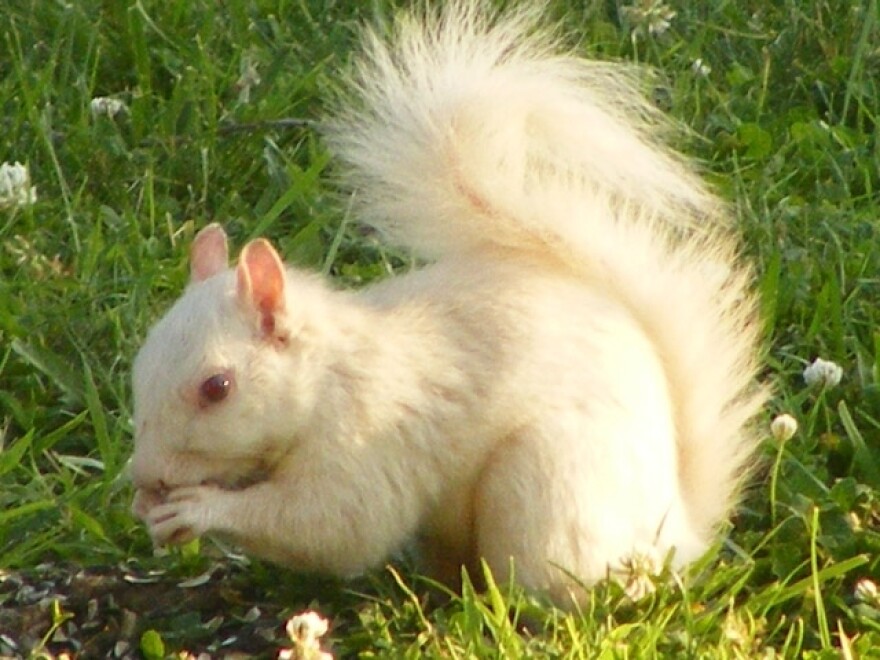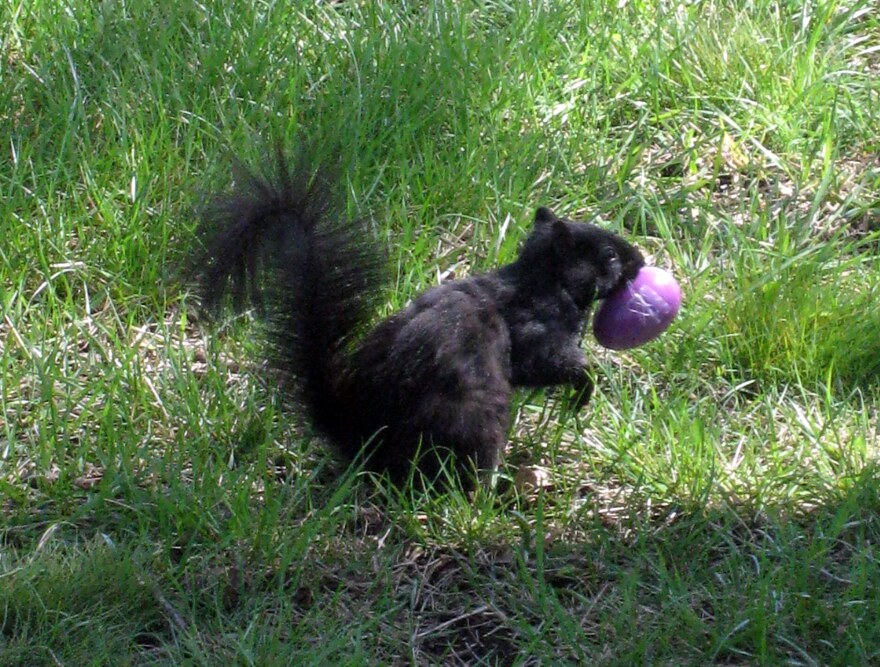This story was rebroadcast as part of our best-of 2015 series. It was originally reported in August 2015.
Squirrels can be found just about anywhere in the Kansas City area, from the densest parts of the urban core, to rural prairie or forest settings.
They typically are a grayish color, brown or an orangey red, but recent black squirrels sightings in one Northland neighborhood have residents curious about the origins of their new dark furry neighbors.
“It’s weird. Two or three years ago if you had asked me if there is such a thing as a black squirrel, I would have said no. I had no idea,” says Dave Wood who lives on Erie Street in North Kansas City.
But now, Wood says, on his street the creatures are pretty commonplace.
One of the black squirrel hot beds seems to be a few houses down at Ken and Marilyn Karnes’ home. Ken Karnes has lived on this street for 77 years and can verify that it’s only been about the past three years since he’s started seeing black squirrels in the area. There’s a nest of them in a tree in his front yard — one even scampers across the street while we’re talking.
“Black squirrels seem to like the easy life on Erie Street,” Karnes jokes.

Karnes says he doesn’t know why there seem to be more black squirrels on his street or where they came from. But there are scientists who are tracking squirrel color and how the animal moves.
Black squirrel genetics
There are three species of squirrels native to Missouri: the eastern gray squirrel, the fox squirrel and the southern flying squirrel. The most common species you see are the eastern gray squirrel and the fox squirrel. Both these species can be found in any color phase from black, to gray to even to white and everything in between.
Helen McRobie is a squirrel researcher and teaches at Anglia Ruskin University in the United Kingdom. She discovered the genetic difference that causes some eastern gray squirrels to be black — a mutation.
“This might have happened millions of years ago,” says McRobie. “The gray squirrel is much older than the black squirrel. So the black squirrel gene has somehow mutated.”

McRobie explains further, “A normal gray squirrel if you look very closely at their individual hairs, they are actually stripy. They’re made up of white, black, and orange colors. But from a distance they look gray. But the black squirrel, the gene that’s involved in the hair color it doesn't make that stripy hair. It just makes a solid black hair.”
She says it’s basically a genetic deletion. A tiny bit of DNA is missing, which makes them black. It’s called melanism.
Six years ago, McRobie started a website called The Black Squirrel Project to look at how black and gray eastern gray squirrels are spreading across the U.K., where they are considered an invasive species.
But she says they are native to North America. McRobie says it’s very common to find melanistic squirrels in the northeastern part of the United States, in Canada, and even pockets in the Midwest. And she is still trying to learn even more about them. She’s even interested in receiving tissue samples of black squirrel road kill if you happen to come across any.
McRobie says there are theories out there that black squirrels have an advantage in colder climates, or camouflage better in forest settings and shade, but nobody knows for certain.
“I don’t think they have an advantage over the grays, they’re just sort of interbreeding as they go,” says McRobie.
She says black squirrels are expanding their territory naturally. And humans have also played a role.

“They’ve been moved around in America by people so it’s hard to know what’s a natural spread by the squirrels and what’s people interfering,” says McRobie.
Marysville, Kansas: 'Black Squirrel City'
One example of how humans have potentially interfered is in Marysville, Kansas, a town about two hours west of Kansas City. They consider themselves a black squirrel city. Brenda Staggenborg, with the Marysville Chamber of Commerce, says black eastern gray squirrels make up about half of the city's squirrel population, and it all started with the circus.
“In the 1920s there was a traveling carnival or circus in town that had cage of black squirrels, and one night a child opened the cage and let them out,” says Staggenborg.
Now the squirrels have grown to be a tourist attraction for the town. They are the town mascot, and are protected by city ordinance. Staggenborg says you are not allowed to trap or kill them, they are permitted on city property, they have the right of way on the roads and they get the first pick of the black walnuts.
Marionville, Missouri: 'Home of the white squirrel'

Marionville, Missouri, a town about three hours south of Kansas City, is the home of the white squirrel, which is caused by a different genetic mutation.
Doris Rapp, who has been the mayor for eight years, says the large population of squirrels could also possibly be credited to a traveling circus more than a 100 years ago, or possibly, a scientist who was breeding them. Either way, they are also protected by ordinance and have become a symbol of the town.
Squirrels of all colors have proven to be highly adaptive creatures
Squirrel researcher Steve Sullivan says he hears a lot of circus theories when it comes to towns explaining their rare squirrel populations.
“There is a nugget of truth to that,” says Sullivan. But he says the origin isn’t always the circus.
Another theory is that those genes have always been in your town, says Sullivan.
“It’s been relatively recent that we as a species, as a population, have stopped hunting squirrels,” he says. That, along with other ordinances that protect them, gives them a boost he says.
Sullivan also notes that even without human interference squirrels can travel long distances on their own, and it could be as simple as the right squirrel immigrant bringing in the right gene combination to result in more rare colors.
Sullivan, who works with Project Squirrel, a site monitoring squirrel activity in the Untied States, says black eastern gray squirrel populations are growing, the white ones are more rare, but they both have a way of getting people’s attention.
“People are used to seeing a certain color phase, the common color phase. And when something odd shows up they find it fascinating,” says Lonnie Hansen, retired squirrel specialist for the Missouri Department of Conservation.
Hansen says he used to get all types of squirrel calls. It seems like everybody has some squirrel story. From people reporting different colors, to people complaining about them. But Hansen says for the most part people enjoy them, and the overall population of all the species is doing just fine in Missouri.
“Some people wish we had far fewer in urban settings,” says Hansen. “But you know, that’s part of their ability to adapt — is how well they do in those highly manipulated urban settings. And so that’s kind of why I admire them so much.”
This look at the Northland is part of KCUR's months-long examination of how geographic borders affect our daily lives in Kansas City. KCUR will go Beyond Our Bordersand spark a community conversation through social outreach and innovative journalism.
We will share the history of these lines, how the borders affect the current Kansas City experience and what’s being done to bridge or dissolve them.



